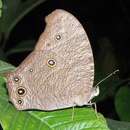en
names in breadcrumbs


Melanitis leda, the common evening brown,[1][2] is a common species of butterfly found flying at dusk. The flight of this species is erratic. They are found in Africa, South Asia and South-east Asia extending to parts of Australia.[1][2]
Wet-season form: Forewing: apex subacute; termen slightly angulated just below apex, or straight. Upperside brown. Forewing with two large subapical black spots, each with a smaller spot outwardly of pure white inwardly bordered by a ferruginous interrupted lunule; costal margin narrowly pale. Hindwing with a dark, white-centred, fulvous-ringed ocellus subterminally in interspace two, and the apical ocellus, sometimes also others of the ocelli, on the underside, showing through.[3]
Underside paler, densely covered with transverse dark brown striae; a discal curved dark brown narrow band on forewing; a post-discal similar oblique band, followed by a series of ocelli: four on the forewing, that in interspace 8 the largest; six on the hindwing, the apical and subtornal the largest.[3][4]
Dry-season form: Forewing: apex obtuse and more or less falcate; termen posterior to falcation straight or sinuous. Upperside: ground colour similar to that in the wet-season form, the markings, especially the ferruginous lunules inwardly bordering the black sub-apical spots on forewing, larger, more extended below and above the black costa. Hindwing: the ocellus in interspace 2 absent, posteriorly replaced by three or four minute white subterminal spots.[3]
Underside varies in colour greatly. Antennae, head, thorax and abdomen in both seasonal forms brown or greyish brown: the antennae annulated with white, ochraceous at apex.[3]
Resident butterflies are known to fight off visitors to the area during dusk hours.[5] This chase behaviour is elicited even by pebbles thrown nearby.[6]
The caterpillars feed on a wide variety of grasses including rice (Oryza sativa), bamboos, Andropogon, Rotboellia cochinchinensis,[7] Brachiaria mutica,[7] Cynodon, Imperata, and millets such as Oplismenus compositus,[8] Panicum and Eleusine indica.[9]
Adults feed mainly on nectar, and in rare cases visit rotting fruits.[10]
Melanitis leda, the common evening brown, is a common species of butterfly found flying at dusk. The flight of this species is erratic. They are found in Africa, South Asia and South-east Asia extending to parts of Australia.